Jenkins Music Company Building
Introduction
Text-to-speech Audio
The Jenkins Music Company Building in Kansas City, Missouri, was originally constructed in 1911-1912. The building was built to serve as the general offices, retail headquarters and the wholesale division of the prominent musical instrument and music publishing firm, the Jenkins Music Company, founded in 1878 by John Wesley Jenkins, Sr. During the 1890’s, the Jenkins Company became one of the largest manufacturers of guitars and mandolins in the world and one of the most distinguished publishers of sheet music in the nation. The structure was designed by locally-based architectural firm, Smith, Rea & Lovitt, especially by the firm's senior partner, Charles A. Smith. It is a significant example of unaltered, Modernistic-style commercial architecture, combining Late Gothic Revival and Art Deco decorative elements. The building was added to the National Register of Historic Places in 1979.
Images
The historic Jenkins Music Company Building in 2022




Backstory and Context
Text-to-speech Audio
John Wesley Jenkins, Jr., the son of the original music store’s founder, was brought into the company in the 1880s. With his brothers, after the death of their father, they formed the J.W. Jenkins’ Son’s Music Company in 1890. After three moves, the company settled at the current Walnut Street address in the Central Business District of Kansas City, Missouri, in 1912, originally constructed as a 6-story fireproof building. The firm of Smith, Rea & Lovitt was a distinguished architecture firm in Kansas City with a national reputation. Among the other Kansas City buildings the firm designed are the Rialto Building, the Ivanhoe Temple, the Isis Theater/Wirthnam Building and the Firestone Building.
The same architectural firm handled the Jenkins Music Company Building's renovation of 1931-1932. At about 132 feet in height, the structure is constructed with a steel and reinforced concrete frame, with a red brick side and rear walls with exposed concrete framing. The most ornate area of the building's exterior is the west facade, with embellishments and step-backs on the eighth story creating a strong vertical and rectilinear impression. On this facade, a basecourse of Black basalt is visually surmounted by Black-colored terra cotta which surfaces the ground and mezzanine stories.
According to a 1932 music magazine article, at the time of its restoration, the Jenkins Building was a unique institution, with features on every floor. On the first floor was a salesroom for band and orchestra instruments, sheet music, and records. The mezzanine had a department displaying rare violins. The second floor included more sheet music and books. The third floor had more musical merchandise, the fourth contained the radio and refrigerator departments and the fifth contained the executive offices as well as a remote-control broadcasting studio. The seventh floor was devoted to a display of grand pianos and the eighth floor contained 23 music studios and an auditorium/recital hall with a seating capacity of 240.
In 1947, the first of eight annual summer conferences of new music was held in the building, with several hundred of the nation’s most prominent composers, musicians and music teachers discussing music composition and materials, and new trends in music. At the height of its success in the 1950s, the company employed 700 people, though by August 1971, it had declared bankruptcy. In July 1973, David Richardson, founder of Rich Music Co., purchased the Jenkins company and closed many of its properties, including the main downtown Kansas City building. It is now connected to a parking lot constructed for the 1201 Walnut Street high-rise: only the west facade of the original structure is intact. Historic preservationists fought to save the facade in a manner similar to Kansas City's Harzfeld's Building. According to the building's current owner, the property is to be redeveloped into a mixed-use project with commercial space on the ground floor and loft style apartments in the balance of the space.
The last Jenkins Music Store was closed in Midwest City, Oklahoma, in December 2014, decades after its namesake company went bankrupt. As the store’s 75-year-old owner, Ken Leerstang, said, “It used to be that when you wanted a musical instrument, you had to go to a music store. Now you can go on the Internet and get whatever you want.”
Cite This Entry
Admin, Clio. "Jenkins Music Company Building." Clio: Your Guide to History. August 2, 2023. Accessed July 29, 2025. https://theclio.com/entry/47135
Sources
Miszczuk, Edward J. "NRHP Nomination Form." United States Department of the Interior - National Park Service. Publication Date: 3/5/78. Access Date: 10/15/17. http://www.dnr.mo.gov/shpo/nps-nr/79001370.pdf.
"Jenkins Music Company Building.” Emporis – Buildings. Access Date: 10/15/17. https://www.emporis.com/buildings/192422/jenkins-music-company-building-kansas-city-mo-usa.
“Jenkins Music Company Building.” Facebook.com. https://www.facebook.com/pages/Jenkins-Music-Company-Building/201520099900452.
KanMando (registered user). "Re: Harwood mandolins and guitars." Mandolin Café. Publication Date: 1/11/12. Access Date: 10/15/17. https://www.mandolincafe.com/forum/showthread.php?38906-Harwood-mandolins-and-guitars/page6.
"Old Photos: Jenkins Music Company." Kansas City with a Russian Accent. Publication Date: 8/25/10. Access Date: 10/15/17. http://kcmeesha.com/2010/08/25/old-photos-jenkins-music-company/.
“Our Properties: Jenkins Music Company Lofts.” Copaken Brooks Commercial Real Estate; Access Date: 10/15/17. http://copaken-brooks.com/jenkins-music-company-lofts.
Bailey, Briana. "Musical finale: Closing at year's end, Midwest City's Jenkins Music can trace its roots to long-gone Kansas City chain." NewsOK.com. Publication Date: 12/4/14. Access Date: 10/15/17. http://newsok.com/article/5372287.
Photo by David Trowbridge

